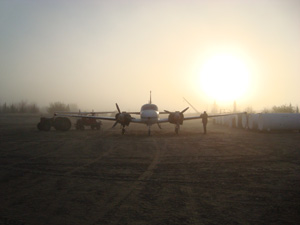
A mineral exploration is conducted in several stages, and
the prospecting stage is arguably one of the most important. Mineral
prospecting can be done in various different ways and geophysical surveys are
enabling mining companies to acquire highly accurate results with regards to
the mineral concentrations in the Earth's crust. There are two specific types
of airborne surveys that can be employed in a prospecting project: detailed and
regional.
There are two methods of prospecting that a detailed survey
is completed for: direct and indirect. Surveys conducted as a direct
prospecting method are employed to gain a detailed perspective on the
concentrations of magnetic ores such as magnetic iron ores, chrome and
kimberlites. Aeromagnetic surveys will uncover high concentrations of
commodities that are highly sought after by the mining industry. Concentration
levels of these minable commodities are reflected in the magnetic fields in the
space directly above the land.
The other method is called indirect prospecting, used as a
means of discovering the structural body, depth and geometry of a specific
area. Indirect prospecting assists in the task of mapping out weak magnetic
fields
as well as successfully discriminating between
conductors that are both metallic and non-metallic.
Detailed aeromagnetic surveys offer data at a higher
resolution using a traverse line spacing of under 250 meters. As such, these
surveys are able to act as sufficient mineral prospecting tools for magnetic
iron ores and kimberlites. A detailed survey is capable of helping to assess
the body and depth of the land that will be explored, and can locate specific
basement targets in hydrocarbon exploration.
Regional aeromagnetic surveys assess a large terrain of
usually more than 5000 square kilometers, with a traverse line spacing of up to
500 meters. These surveys are employed to look for commodities such as coal and
petroleum. Mining companies prospect for these as well as use regional
surveying as a means of prospecting for other non-metallic valuable substances
that can be found in the basement surface.
While there are several different ways of conducting a
geophysical survey as a means of mineral prospecting, airborne magnetic surveys
are the most commonly used surveys for this purpose. Airborne magnetic surveys
work by employing the use of a magnetometer, either attached to the aircraft or
towed behind, and work by detecting ambient magnetic fields that are caused by
minerals in the subsurface of the Earth.
Similar to handheld magnetic surveys, airborne magnetic
surveys enable a vast space to be assessed at one time. While the aircraft is
in flight, the magnetometer will test the magnetic fields over the land
including the spatial variations that are a result of the regional magnetic field
and the concentrations of the minerals under the surface of the Earth. Minerals
that can be detected are uranium, titanium, base and precious metals,
kimberlites, and minable magnetic ores.
While aeromagnetic surveys are highly useful in mineral prospecting,
there are certain areas that are covered by heavy bedrock and other factors
that can obstruct the presence of ambient magnetic fields. In such cases,
mining companies will use airborne electromagnetic surveys as a prospecting
tool.
Using the concept of induction, electromagnetic surveys
induce an electric current through a coal that is passed underground. When the
coil is underground, an eddy current develops.
The eddy current will begin to circulate and become stronger
the closer it gets to a conductive zone and, in turn, a secondary current will
develop.
Electromagnetic surveys are cost-efficient ways of mineral
prospecting. However, it is important to remember that there will be certain
factors that can interfere with the acquiring of accurate data. These factors
are labeled geological noise and can disrupt electromagnetic currents.
Geophysical surveys are an extremely helpful tool in the
mineral prospecting stage of an exploration and mining companies depend heavily
upon their results in order to render profitable expeditions.